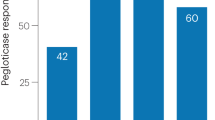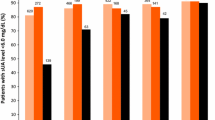Abstract
Successful management of chronic gout depends on reducing body pools of urate. The benchmark of success is to maintain serum urate levels at less than 6 mg/dL using therapies such as probenecid or allopurinol. In a subset of patients with gout, these medications fail to achieve this benchmark, resulting in ongoing signs and symptoms characteristic of treatment-failure gout. Potential therapies now in clinical development show promise for treating this refractory patient population. In this article, we review the clinical characteristics associated with treatment-failure gout and discuss recent data from clinical trials of febuxostat and uricase.
Similar content being viewed by others
References and Recommended Reading
Becker MA, Jolly M: Clinical gout and pathogenesis of hyperuricemia. In Arthritis and Allied Conditions: A Textbook of Rheumatology, edn 15, vol. 2. Edited by Koopman WJ, Moreland LW. Philadelphia: Lippincott Williams and Wilkins; 2005:2303–2340.
Sarawate CA, Patel PA, Schumacher HR, et al.: Serum urate levels and gout flares: analysis from managed care data. J Clin Rheumatol 2006, 12:61–65.
Fang W, Zeng X, Li M, et al.: The management of gout at an academic healthcare center in Beijing: a physician survey. J Rheumatol 2006, 33:2041–2049.
Lawry GV 2nd, Fan PT, Bluestone R: Polyarticular versus monoarticular gout: a prospective, comparative analysis of clinical features. Medicine (Baltimore) 1988, 67:335–343.
Mikuls TR, Curtis JR, Allison JJ, et al.: Medication errors with the use of allopurinol and colchicine: a retrospective study of a national, anonymous Internet-accessible error reporting system. J Rheumatol 2006, 33:562–566.
Mikuls TR, Farrar JT, Bilker WB, et al.: Suboptimal physician adherence to quality indicators for the management of gout and asymptomatic hyperuricaemia: results from the UK General Practice Research Database (GPRD). Rheumatology (Oxford) 2005, 44:1038–1042.
Mikuls TR, MacLean CH, Olivieri J, et al.: Quality of care indicators for gout management. Arthritis Rheum 2004, 50:937–943.
Mikuls TR, Saag KG: Gout treatment: what is evidence-based and how do we determine and promote optimized clinical care? Curr Rheumatol Rep 2005, 7:242–249.
Neogi T, Hunter DJ, Chaisson CE, et al.: Frequency and predictors of inappropriate management of recurrent gout attacks in a longitudinal study. J Rheumatol 2006, 33:104–109.
Pal B, Foxall M, Dysart T, et al.: How is gout managed in primary care? A review of current practice and proposed guidelines. Clin Rheumatol 2000, 19:21–25.
Sarawate CA, Brewer KK, Yang W, et al.: Gout medication treatment patterns and adherence to standards of care from a managed care perspective. Mayo Clin Proc 2006, 81:925–934.
Smith P, Karlson N, Nair BR: Quality use of allopurinol in the elderly. J Qual Clin Pract 2000, 20:42–43.
Becker MA, Schumacher HR Jr, Wortmann RL, et al.: Febuxostat compared with allopurinol in patients with hyperuricemia and gout. N Engl J Med 2005, 353:2450–2461.
Hande KR, Noone RM, Stone WJ: Severe allopurinol toxicity. Description and guidelines for prevention in patients with renal insufficiency. Am J Med 1984, 76:47–56.
Dalbeth N, Kumar S, Stamp L, Gow P: Dose adjustment of allopurinol according to creatinine clearance does not provide adequate control of hyperuricemia in patients with gout. J Rheumatol 2006, 33:1646–1650.
Vazquez-Mellado J, Morales EM, Pacheco-Tena C, Burgos-Vargas R: Relation between adverse events associated with allopurinol and renal function in patients with gout. Ann Rheum Dis 2001, 60:981–983.
Hahn PC, Edwards NL: Management of hyperuricemia. In Arthritis and Allied Conditions: A Textbook of Rheumatology, edn 15, vol. 2. Edited by Koopman WJ, Moreland LW. Philadelphia: Lippincott Williams and Wilkins; 2005:2341–2355.
de Klerk E, van der Heijde D, Landewe R, et al.: Patient compliance in rheumatoid arthritis, polymyalgia rheumatica, and gout. J Rheumatol 2003, 30:44–54.
Riedel AA, Nelson M, Joseph-Ridge N, et al.: Compliance with allopurinol therapy among managed care enrollees with gout: a retrospective analysis of administrative claims. J Rheumatol 2004, 31:1575–1581.
Sundy JS, Becker MA, Schumacher HR, et al.: Multicenter longitudinal study of disease characteristics in patients with treatment failure gout. Ann Rheum Dis 2006, 65:272.
Sundy JS, Schumacher HR, Becker MA, et al.: Quality of life in patients with treatment failure gout. Ann Rheum Dis 2006, 65:271.
Becker MA, Kisicki J, Khosravan R, et al.: Febuxostat (TMX-67), a novel, non-purine, selective inhibitor of xanthine oxidase, is safe and decreases serum urate in healthy volunteers. Nucleosides Nucleotides Nucleic Acids 2004, 23:1111–1116.
Becker MA, Schumacher HR Jr, Wortmann RL, et al.: Febuxostat, a novel nonpurine selective inhibitor of xanthine oxidase: a twenty-eight-day, multicenter, phase II, randomized, double-blind, placebo-controlled, doseresponse clinical trial examining safety and efficacy in patients with gout. Arthritis Rheum 2005, 52:916–923.
Hoshide S, Takahashi Y, Ishikawa T, et al.: PK/PD and safety of a single dose of TMX-67 (febuxostat) in subjects with mild and moderate renal impairment. Nucleosides Nucleotides Nucleic Acids 2004, 23:1117–1118.
Ames BN, Cathcart R, Schwiers E, Hochstein P: Uric acid provides an antioxidant defense in humans against oxidant-and radical-caused aging and cancer: a hypothesis. Proc Natl Acad Sci U S A 1981, 78:6858–6862.
Wu X, Wakamiya M, Vaishnav S, et al.: Hyperuricemia and urate nephropathy in urate oxidase-deficient mice. Proc Natl Acad Sci U S A 1994, 91:742–746.
Kelly SJ, Delnomdedieu M, Oliverio MI, et al.: Diabetes insipidus in uricase-deficient mice: a model for evaluating therapy with poly(ethylene glycol)-modified uricase. J Am Soc Nephrol 2001, 12:1001–1009.
Moolenburgh JD, Reinders MK, Jansen TL: Rasburicase treatment in severe tophaceous gout: a novel therapeutic option. Clin Rheumatol 2006, 25:749–752.
Richette P, Bardin T: Successful treatment with rasburicase of a tophaceous gout in a patient allergic to allopurinol. Nat Clin Pract Rheumatol 2006, 2:338–342; quiz 343.
Rozenberg S, Roche B, Dorent R, et al.: Urate-oxidase for the treatment of tophaceous gout in heart transplant recipients. A report of three cases. Rev Rhum Engl Ed 1995, 62:392–394.
Vogt B: Urate oxidase (rasburicase) for treatment of severe tophaceous gout. Nephrol Dial Transplant 2005, 20:431–433.
Davis S, Park YK, Abuchowski A, Davis FF: Hypouricaemic effect of polyethyleneglycol modified urate oxidase. Lancet 1981, 2:281–283.
Chua CC, Greenberg ML, Viau AT, et al.: Use of polyethylene glycol-modified uricase (PEG-uricase) to treat hyperuricemia in a patient with non-Hodgkin lymphoma. Ann Intern Med 1988, 109:114–117.
Ganson NJ, Kelly SJ, Scarlett E, et al.: Control of hyperuricemia in subjects with refractory gout, and induction of antibody against poly(ethylene glycol) (PEG), in a phase I trial of subcutaneous PEGylated urate oxidase. Arthritis Res Ther 2006, 8:R12.
Sundy JS, Ganson NJ, Kelly SJ, et al.: Pharmacokinetics and pharmacodynamics of intravenous PEGylated recombinant mammalian urate oxidase in patients with refractory gout. Arthritis Rheum 2007, 56:1021–1028.
Sundy JS, Becker MA, Baraf HS, et al.: A phase 2 study of multiple doses of intravenous polyethylene glycol (PEG)-uricase in patients with hyperuricemia and refractory gout [abstract]. Arthritis Rheum 2005, 52:S679.
Baraf HS, Kim S, Matsumoto AK, Maroli AN: Resolution of tophi with intravenous PEG-uricase in refractory gout [abstract]. Arthritis Rheum 2005, 52:S105.
Perez-Ruiz F, Calabozo M, Pijoan JI, et al.: Effect of urate-lowering therapy on the velocity of size reduction of tophi in chronic gout. Arthritis Rheum 2002, 47:356–360.
Author information
Authors and Affiliations
Corresponding author
Rights and permissions
About this article
Cite this article
Sundy, J.S., Hershfield, M.S. Uricase and other novel agents for the management of patients with treatment-failure gout. Curr Rheumatol Rep 9, 258–264 (2007). https://doi.org/10.1007/s11926-007-0041-y
Published:
Issue Date:
DOI: https://doi.org/10.1007/s11926-007-0041-y




